|


256-bit encryption
$500,000 protection

|
AMERICA 1851 boat model
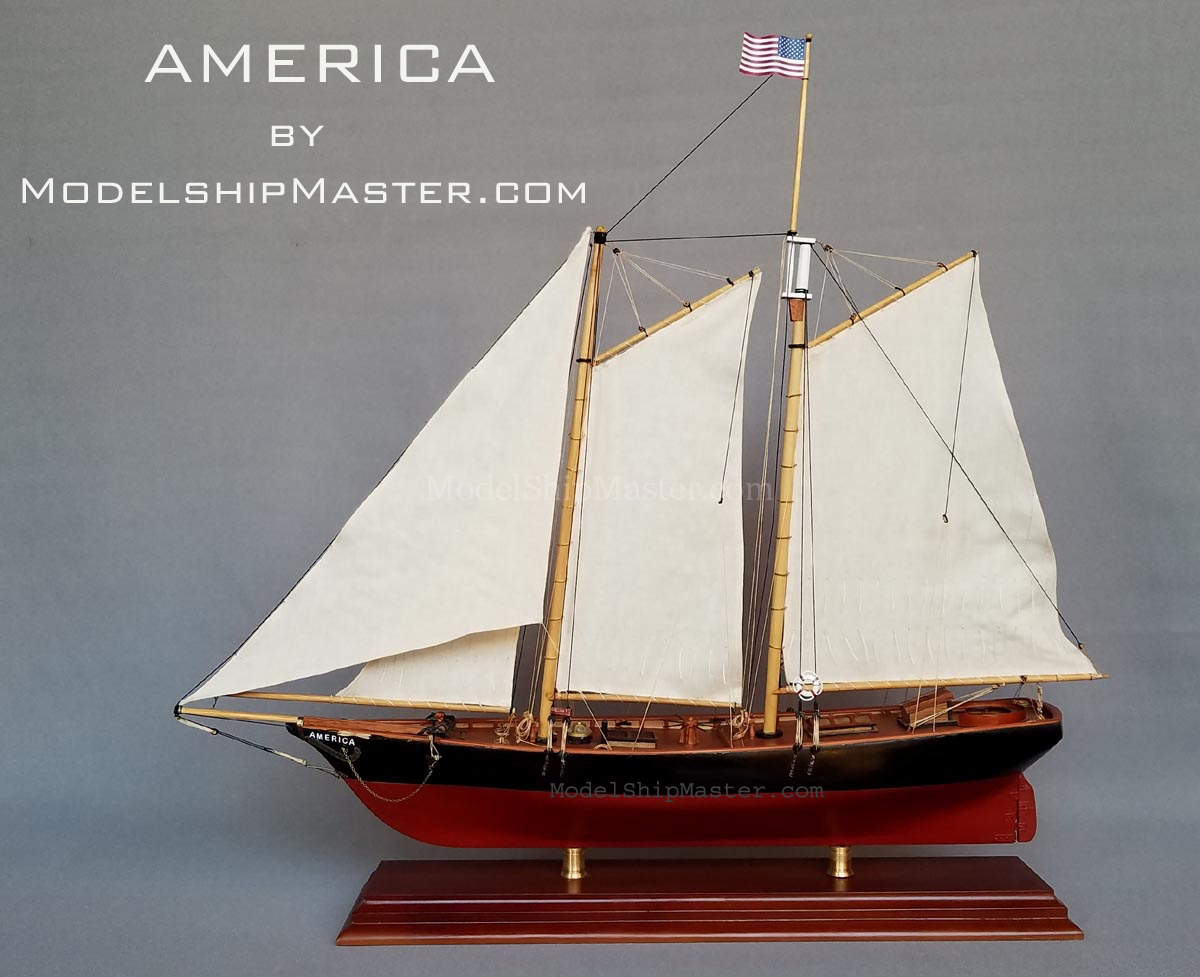
America is a 19th-century 97-tonne racing yacht and first winner
of the America's Cup international sailing trophy.
In 1848,
Queen Victoria authorized the creation of the "One
Hundred Guinea Cup" that was made of solid silver, standing 27" tall and
weighing 132oz for a yacht race "open to all nations."
In 1851, a syndicate of six wealthy New Yorkers commissioned
a sleek new yacht, named "America", to cross the
Atlantic to take on the 16 yacht strong
British fleet.
The America sailboat was
built at William H. Brown’s shipyard in New York City.
She was launched on 3 May 1851. On 17 May, she went on a
trial run against the sloop Maria, a famous yacht owned
by the Stevens brothers. During these trials, the
America lost her main gaff and foremast, but her
builders were confident that with heavier spars she
would live up to expectations. In the meanwhile, time
was running out for the season to send her to England to
race, so the backers made an offer to the shipyard of
$20,000 in cash and a release from further trials. This
offer was accepted, and, after the necessary alterations
were completed, she was delivered to her owners on 18
June.
The sailboat yacht America
had a deep keel and a steeply raked bow. The keel was a
ballast keel, which meant the boat was at least a foot
deeper in the water than other boats. The ballast keel
also created a steeper dead-rise. W.H. Brown, the designer of the New York
Yacht Club entry was so confident of his design that he
refused payment if America did not win.
On the morning of 21 June 1851, the yacht America, under
Captain Richard Brown and a crew of 12, took her
departure from Sandy Hook and reached Le Havre, France
after 20 days. She then sailed for Cowes, England on 31
July.
On 22 August, commodore Stevens was notified by the
Royal Yacht Squadron that there would be an open
regatta around the Isle of Wight, without restrictions
as to rig or otherwise, and that the boat America would be
welcomed as a competitor. The trophy was the Hundred
Guinea Cup.
The
invitation was accepted, and on the day appointed, the
sailboat
America was at the line waiting for the starting signal.
There were 15 starters: 7 schooners and 8 cutters. At
10:00, the starting gun was fired and the yacht America
was in last place. It was customary in those days to
start a race from “at anchor” instead of using a sailing
start. The boat America overran her anchor and slewed around;
her sails had to be lowered. But having on deck 21
people, the sails were again set with little loss of
time. By 11:30, she had the entire squadron behind her.
Noted that
sailboat America was rigged pilot boat fashion; that is, without
fore topmast and jib-boom. Just before the race,
however, it was decided that she might do better with a
flying jib, so a flying jib and a jib-boom were
obtained. Both the sail and the spar were made by
Michael Ratsey of Cowes. During the race, this spar
carried away, but even with the time it took to clear
the wreckage, together with the loss of the flying jib’s
area in the light airs that followed, her opponents
could not catch her, for when the breeze freshened, she
was still in the lead. She held the lead until the
finish. Second place went to the 47-ton cutter Aurora.
Next was the 80-ton cutter Bacchante, followed by the
50-ton cutter, Eclipse. Fifth place went to the 392-ton,
three-masted schooner, Brilliant. These were the only
yachts in the regatta which were timed.
The event
was so important and aroused so much interest that Queen
Victoria witnessed it from the royal yacht Victoria &
Albert.
The often quoted remark by the Queen was sparked by
boat America's great victory. She asked, "Who is first?"
America has won, she was told. "Who was second", asked
the Queen? The reply still echoes - "Your Majesty, there
is no second."
The sailboat America brought home the 100 Guineas Cup across the
Atlantic, and the New York Yacht Club renamed it "The
America's Cup" after the winning boat.
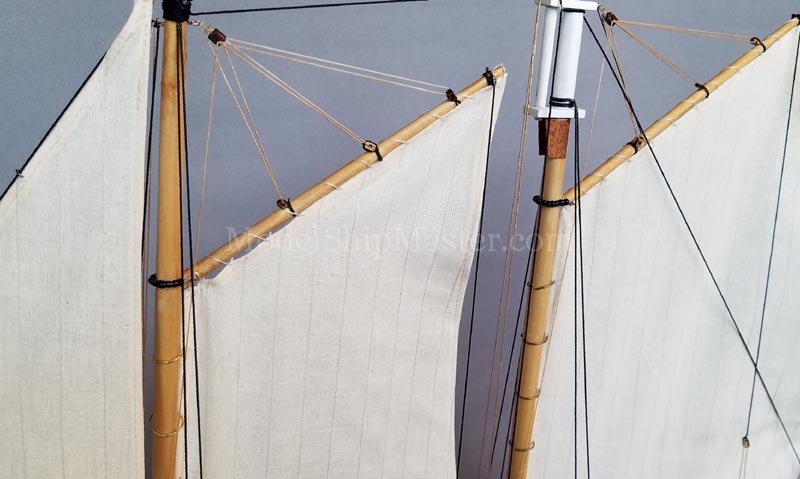
After this
event, the America yacht was offered for sale. She was
purchased by Lord John de Blaquiere, who started to fit
her out at once for a long cruise across the
Mediterranean. In the latter part of November 1851, she
sailed from Plymouth, manned by an English crew. While
in the Mediterranean, she encountered a violent gale
which she rode out undamaged. A letter from the owner
from Malta, written on 6 February 1852, has this to say
of her performance: She is a vessel of remarkable speed
and buoyancy. She will lie within four points of the
wind and do her fifteen knots an hour with ease. ...The
pretty craft nobly did her duty, doing her fourteen
knots, and running with her jib set, and setting all bad
weather at defiance.
In late
July 1852, the America boat ran aground at
Portsmouth, Hampshire and was damaged. De Blaquiere
raced her only a few times before selling her in 1856 to
Henry Montagu Upton, 2nd Viscount Templetown, who
renamed her Camilla. In 1858, she was sold to Henry
Sotheby Pitcher, a shipbuilder in Northfleet, Kent. He
rebuilt Camilla and sold her to Henry Edward Decie in
1860, who brought her back to the United States. Decie
sold the ship to the Confederate States of America the
same year for use as a blockade runner in the American
Civil War, though he remained aboard as captain.
In 1862,
Camilla was scuttled in Dunns Creek, north of Crescent
City, Florida when Union troops took the city of
Jacksonville. She was raised, repaired, and renamed
America by the Union and served the United States Navy
on the blockade until May 1863. She was armed with three
smoothbore bronze cannon. America was assigned to the
federal blockading squadron off Charleston, South
Carolina, and was on patrol the night of March 19, 1863,
when she spotted the smoke of a blockade runner near
Dewees Inlet, South Carolina. She immediately launched
colored signal flares to alert the rest of the fleet.
The runner was the CSS Georgiana which was the most
powerful Confederate cruiser then afloat. America's
action ultimately resulted in the Georgiana's
destruction. In 1863, boat America became a training ship at
the United States Naval Academy.
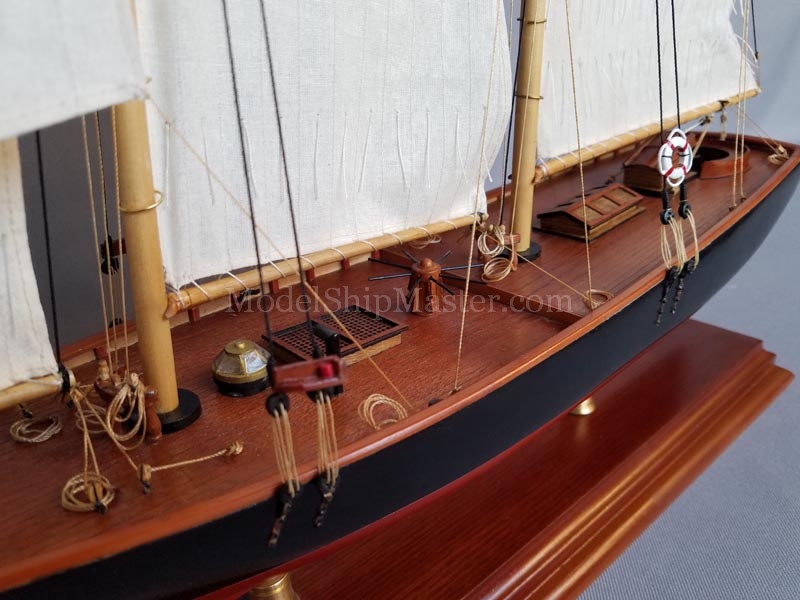
Sailboat America remained in the Navy until 1873, when
she was sold to Benjamin Butler. Butler hired James H.
Reid who was in charge of her for sixteen years. They
raced and maintained her well. America was then sold to
Charles Foster in 1917, and in 1921 was sold to the
America Restoration Fund, which donated her to the U.S.
Naval Academy in Annapolis.
In 1923, yacht America was given the hull designation of
IX-41 by the US Navy. She was not maintained at the
Naval Academy and became seriously decayed by 1940. The
shed which housed America collapsed during a heavy
snowstorm on March 29, 1942. The remains of the shed and
ship were scrapped and burned in 1945.
Sailboat America
was one of only four ships in service in the U.S. Navy
in both the Civil War and World War II, along with the
USS Constitution, USS Constellation, and USS Hartford.
The New York Yacht Club acquired several relics from
yacht America after her destruction. These include her
transom eagle, rudder post and one of her masts. The
mast serves as the flag pole for the club's summer
station in Newport, Rhode Island.
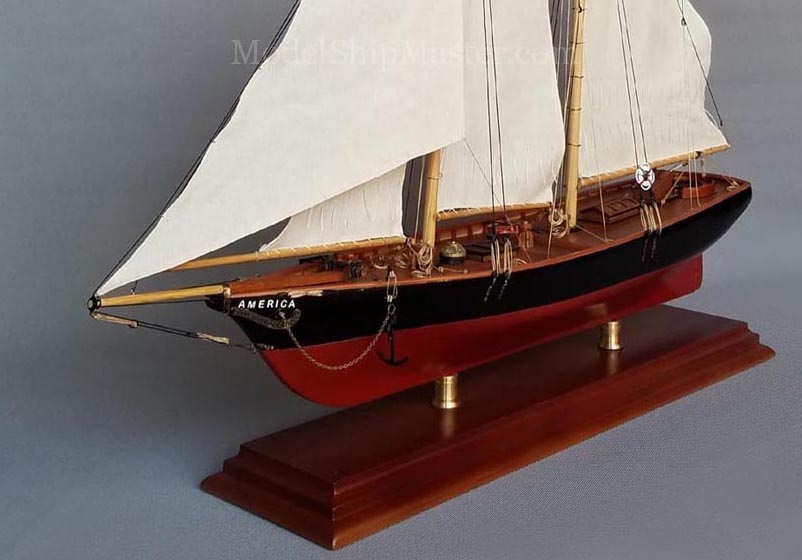
This America yacht model boat
is 26" long x 25" tall x 6"
wide
$2,590
Shipping
and insurance in the US included. Other countries, $300
flat rate.
Model
is built per commission only.
We require only a small deposit to start $500  The
remaining balance won't be due until the model is
completed. Please click
here
for lead time. The
remaining balance won't be due until the model is
completed. Please click
here
for lead time.
A copy
of this
America yacht model has been on displayed since May 2016 in the Museum of
Science and Industry in Chicago.
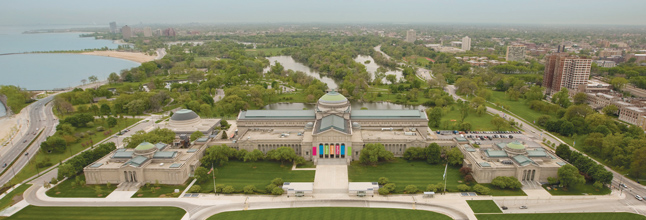
"Hi Frank,
We are in receipt of the America ship model and are very
happy with it! Thank you so much.
It's a beauty!
Margaret
Curator,
Museum of Science and Industry, Chicago"
Learn more about the yacht America here:
https://en.wikipedia.org/wiki/America_(yacht)https://www.usni.org/magazines/proceedings/1967/september/u-s-schooner-yacht-america
|